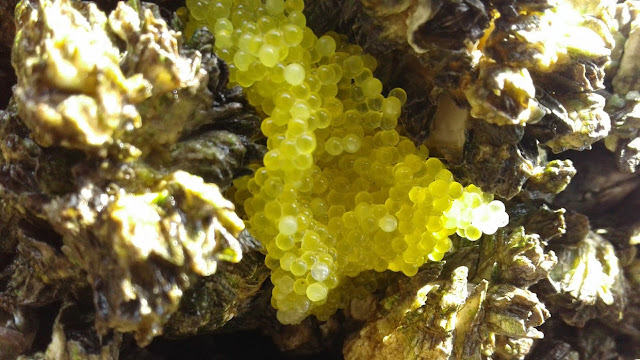Spring, Sprang!
Spring has sprung at Haystack Rock and with it volunteer and staff Environmental Interpreters are finding loads of eggs and tiny juvenile recruits of different types. There have also been very interesting sightings of more precarious types that come with warmer weather; read our HRAP "nature notes" to learn more....
Bright yellow Tidepool Sculpin, Oligocottus maculosus, eggs can be found among the barnacles and mussels, often above the tide pools during low tide. Sculpin can vary in color from red-brown to green and can grow up to 9cm long.
Tiny, juvenile Acorn Barnacle recruits dot the intertidal like adorable polka dots. These animals have small, white volcano-like shells and are very common in the tide pools at Haystack Rock and elsewhere along the Oregon coast.
Highly camouflaged Barnacle Nudibranchs can be seen amongst their eggs (the white, ribbon like blobs) as well as barnacles, anemones and snails. You can, again, see many barnacle recruits in this picture.
Juvenile sea stars can be seen around the intertidal as of late. While sea star populations continue to be low due to the shock of the devastating sea star wasting event which began in 2013 and resulted in over 90% species loss (at Haystack Rock), we are hopeful that some of these juveniles are building up immunities to the virus and are adapting to their ever changing environment. This particular species of sea star, which is most common at Haystack Rock can grow up to 25cm and is generally purple or orange.
The picture above is a common site once nesting season begins at the rock (March - September) -- staff and volunteers often rescue injured or malnourished sea birds that are found on the beach. If you ever happen across a sea bird on the beach, it is most likely injured or needing some type of assistance; notify your local Police Department (non-emergency number) or Wildlife Center and they will generally respond promptly.
Other random fun notes from our "nature notes" (scribed from our daily beach log) this past week that are just too good to leave out:
March 21st: "2 sea stars in garden, large pyrosome's, nudibranch ribbon eggs, eagle came and failed, very windy, osprey flyby at start of shift"
March 24th: "Kite boarder south of needles catching air off waves. Super windy and sideways rain. Left beach early due to nasty conditions and lack of visitors. No common Murres"
March 25th: "Peregrine at top of rock, Western Gull caught crab, baby stars in high intertidal, tried rope along north and it seemed to help, heard Black Oystercatchers down at needles, huge north swells, Canadians and Portlandians visitors"
March 26th: "No murres. One female homo sapiens, skinny dipping north of ''Rock". Murres showed up at 4:00, about 200. Opalescent Nudibranchs in South pools and opalescent swimming upside down, shaggy mouse, ribbon eggs, babies on back wall. Went over to needles to pull guy off rock and there are SEASTARS EVERYWHERE!!"
Tidepool Sculpin, Oligocottus maculosus, eggs
Acorn Barnacle, Balanus glandula, recruits
Barnacle Nudibranchs, Onchidoris bilamellata, and eggs
Highly camouflaged Barnacle Nudibranchs can be seen amongst their eggs (the white, ribbon like blobs) as well as barnacles, anemones and snails. You can, again, see many barnacle recruits in this picture.
Ochre Sea Star, Pisaster ochraceus
Ochre Sea Star, Pisaster ochraceus
Lead Environmental Interpreter, Kari, rescuing a Common Murre, Uria aalge
The picture above is a common site once nesting season begins at the rock (March - September) -- staff and volunteers often rescue injured or malnourished sea birds that are found on the beach. If you ever happen across a sea bird on the beach, it is most likely injured or needing some type of assistance; notify your local Police Department (non-emergency number) or Wildlife Center and they will generally respond promptly.
Other random fun notes from our "nature notes" (scribed from our daily beach log) this past week that are just too good to leave out:
March 21st: "2 sea stars in garden, large pyrosome's, nudibranch ribbon eggs, eagle came and failed, very windy, osprey flyby at start of shift"
March 24th: "Kite boarder south of needles catching air off waves. Super windy and sideways rain. Left beach early due to nasty conditions and lack of visitors. No common Murres"
March 25th: "Peregrine at top of rock, Western Gull caught crab, baby stars in high intertidal, tried rope along north and it seemed to help, heard Black Oystercatchers down at needles, huge north swells, Canadians and Portlandians visitors"
March 26th: "No murres. One female homo sapiens, skinny dipping north of ''Rock". Murres showed up at 4:00, about 200. Opalescent Nudibranchs in South pools and opalescent swimming upside down, shaggy mouse, ribbon eggs, babies on back wall. Went over to needles to pull guy off rock and there are SEASTARS EVERYWHERE!!"
Have a murre-velous day!
--Tuff the Tufted Puffin










Comments
Post a Comment